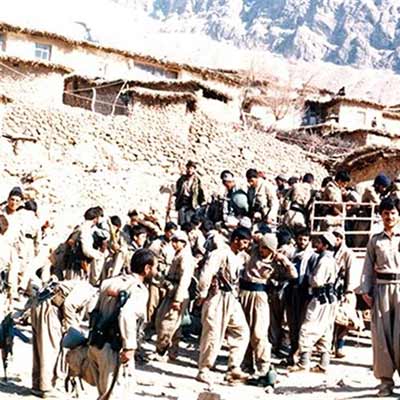Operation Fath-10
Azamsadat Hosseini
211 بازدید
Operation Fath-10 was carried out in the northeast of Erbil Province, Iraq, on September 1987. The commanders and forces under the command of the Islamic Revolutionary Guards Corps' Ramadan Base designed and implemented this guerrilla operation.
The forces of the 58th Malik Ashtar Brigade of the IRGC Ground forces, in cooperation with the Mujahideen of the Supreme Majlis of the Islamic Revolution of Iraq and the Peshmerga of the Iraqi Kurdish Hezbollah, were the operating forces in this operation. The purpose of this operation was to respond to Iraq’s bombing of Iranian civilian centers and the shelling of Kurdshin villages.[1] In the northern front, several goals were pursued, of which securing the borders was a part of it. Preventing the crossings of anti-revolutionary forces and infiltrating elements of the enemy was another of these objectives. By blocking the border crossings, irregular operations were brought down to a minimum. Ambushes, assassinations, hostage taking, bombings and landmines were greatly reduced. Additionally, the presence of Iraq's resources and economic facilities in Kirkuk, Erbil and Sulaymaniyah added to the importance of this front. The operation in Erbil jeopardized the security of the transfer of Iraqi oil to the coast of Turkey in the Mediterranean Sea, and the capture of Sulaymaniyah, while being a step towards Kirkuk, increased the pressure of the Kurdish opposition on the Iraqi government.
Since autumn of 1985, with the announcement of the serious readiness of the opposing Kurds of Iraq to cooperate with the Iranian armed forces, the Revolutionary Guards established the Ramadan Base in order to direct irregular operations. With this, the strategy of pursuing the aggressor in the northern front was adopted. In this way, the time limit of the operation was removed and the Iranian armed forces tried to keep the northern front active in winter. The opposition forces in the Kurdistan Democratic Party of Iraq, who had Erbil Province under their influence, had the largest share in cooperation with the Islamic Republic of Iran in this axis and participated in several operations under the command of the IRGC's Ramadan Base and the ranger units of this camp. The Patriotic Union of Iraqi Kurdistan also participated in the operations conducted in the Sulaymaniyah and Kirkuk axes under the command of the Ramadan Base.[2]
Guerrilla Operation Fath-10 was carried out at 01:45 on Friday September 3, 1987, with the codename of Aba Abdillah al-Husayn. This operation, like the other series of conquest operations, was carried out in the within the northern front of Iraq and in the northeastern axis of the Kurdish province of Erbil, in the general area of Sidkan. During the early hours of the operation, Iranian forces left their positions and, after announcing the code of the operation and following the principles of camouflage and surprise, penetrated deep into Iraqi territory. The advanced tactics of guerilla warfare, along with the speed of the Iranian forces, was a successful start for this operation. In this surprise attack, 36 protection bases, the headquarters of the light battalion in the heights of this region and the heights of 1636, 1962, 1185, 1198, 1096 came under the complete control of Iranian forces.[3] Furthermore, 15 military vehicles and several Iraqi light and heavy weapons were set on fire, while more than five hundred Iraqi soldiers were killed, wounded and captured. 3rd Lieutenant, Abdulaziz Nafal, Deputy Artillery of the 33rd Division of the 5th Corps of the Iraqi Army, was also captured by Iranian forces. The complete destruction of the headquarters of the Light Battalion under the command of the 45th Division of the Iraqi Army, which was in charge of this operational area, was one of the other achievements of Operation Fath-10. In this operation, the Iranian forces also succeeded in completely destroying fifteen light and heavy vehicles, four engineering vehicles, three large ammunition warehouses, Iraqi telecommunications devices and a large number of their equipment, including dozens of devices, individual weapons, ammunition and several anti-aircraft cannons.[4]
[1] Samii, A., Descriptive record of the operations of eight years of Holy Defense, Vice-Chancellor of Propaganda and Publications of Wali Faqih Agency in the Ground Force, 1997, p. 354.
[2] Rashid, M., Iran-Iraq War Atlas, Tehran: Islamic Revolutionary Guard Corps, Holy Defense Documents and Research Center, 2000, p.84
[3] Habibi, A., Operations Record of the Islamic Guards in the Eight Years of Holy Defense, Tehran: Islamic Revolutionary Guard Corps, Public Relations and Publications Department, Ch 5, 2004, p. 184; Samii, Ali, Descriptive record of operations of eight years of holy defense, p. 354.
[4] Habibi, A., the record of operations of the Islamic armies in the eight years of holy defense, p. 184.



